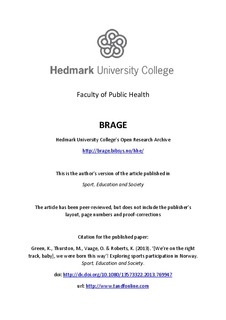| dc.contributor.author | Green, Ken | |
| dc.contributor.author | Thurston, Miranda | |
| dc.contributor.author | Vaage, Odd | |
| dc.contributor.author | Roberts, Ken | |
| dc.date.accessioned | 2013-12-19T07:31:40Z | |
| dc.date.issued | 2013-02-25 | |
| dc.identifier.citation | Green, K., Thurston, M., Vaage, O. & Roberts. K. (2013). “[We’re on the right track, baby], we were born this way”! Exploring sports participation in Norway. Sports, Education and Society. doi: http://dx.doi.org/10.1080/13573322.2013.769947 | no_NO |
| dc.identifier.uri | http://hdl.handle.net/11250/134614 | |
| dc.description | Vitenskapelig, fagfellevurdert artikkel | no_NO |
| dc.description.abstract | Based on quantitative data from the Norwegian Statistisk Sentralbyrå (Statistics Norway) study of Mosjon, Friluftsliv og Kulturaktiviteter (Vaage, 2009), this paper explores trends in Norwegians’ participation in sports, with a focus on young people. Norway boasts particularly high levels of sports participation as well as sports club membership and young Norwegians are the quintessential sporting omnivores. Among other things, the Statistics Norway study reveals substantial increases in participation (among young people and females especially) during the period 1997-2007, a shift in the peak of participation to the late teenage years, a relatively high level of lifelong participants, a re-bound effect in the post-child rearing years and a growth in lifestyle sports. Young Norwegians grow up in a socio-economic context of relative equality between the sexes and high standards of living. An abundance of natural and artificial outdoor and indoor sporting facilities alongside a well-established voluntary sports club sector and an elementary school system that emphasizes physical exercise and recreation, as well as high levels of parental involvement, add to the favourable socio-economic conditions to create seemingly optimal circumstances for sports participation. All this reinforces the sporting and physical recreation cultures deeply-embedded in Norwegian society and embodied by the very many middle-class parents in a country which, for the time being at least, remains relatively young in demographic terms. In terms of lessons to be learned for policy towards sports and physical education beyond Norway, there may be grounds for some optimism around parental involvement in children’s sport as well as the potential appeal of lifestyle sports. That said, it is likely to be the greater socio-economic equalities in Scandinavian countries such as Norway that make them unrealistic benchmarks for sports participation elsewhere. | no_NO |
| dc.language.iso | eng | no_NO |
| dc.publisher | Taylor and Francis | no_NO |
| dc.relation.uri | http://www.tandfonline.com | |
| dc.subject | sport | no_NO |
| dc.subject | participation | no_NO |
| dc.subject | Norway | no_NO |
| dc.subject | lifestyle sports | no_NO |
| dc.subject | youth | no_NO |
| dc.subject | idrett | no_NO |
| dc.subject | deltakelse | no_NO |
| dc.subject | livsstil | no_NO |
| dc.subject | ungdom | no_NO |
| dc.title | “[We're on the right track, baby], we were born this way”! Exploring sports participation in Norway | no_NO |
| dc.type | Journal article | no_NO |
| dc.type | Peer reviewed | no_NO |
| dc.subject.nsi | VDP::Medical disciplines: 700::Health sciences: 800 | no_NO |
| dc.subject.nsi | VDP::Social science: 200 | no_NO |
| dc.description.embargo | 2014-08-25 | |
| dc.source.journal | Sport, Education and Society | no_NO |
| dc.identifier.doi | 10.1080/13573322.2013.769947 | |
